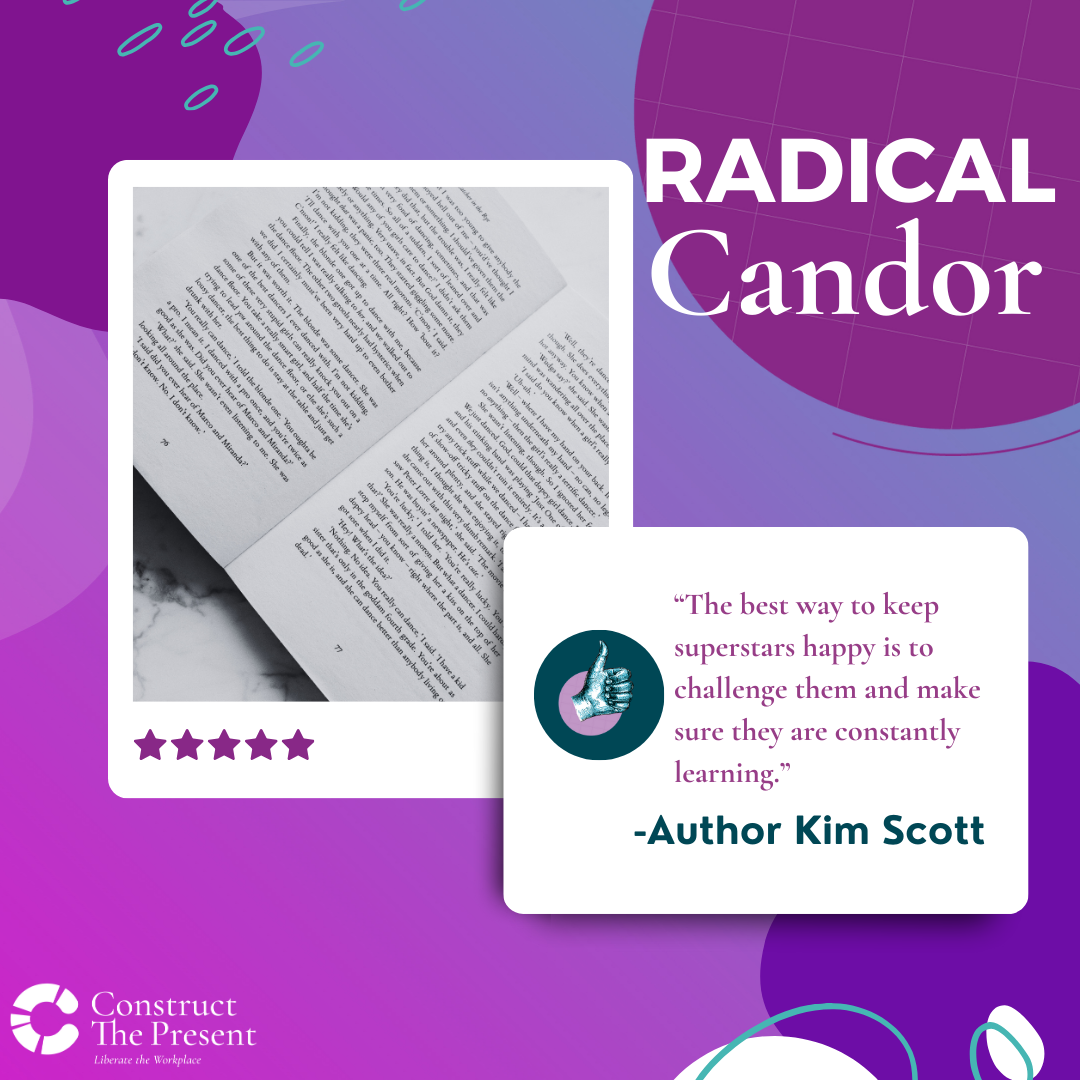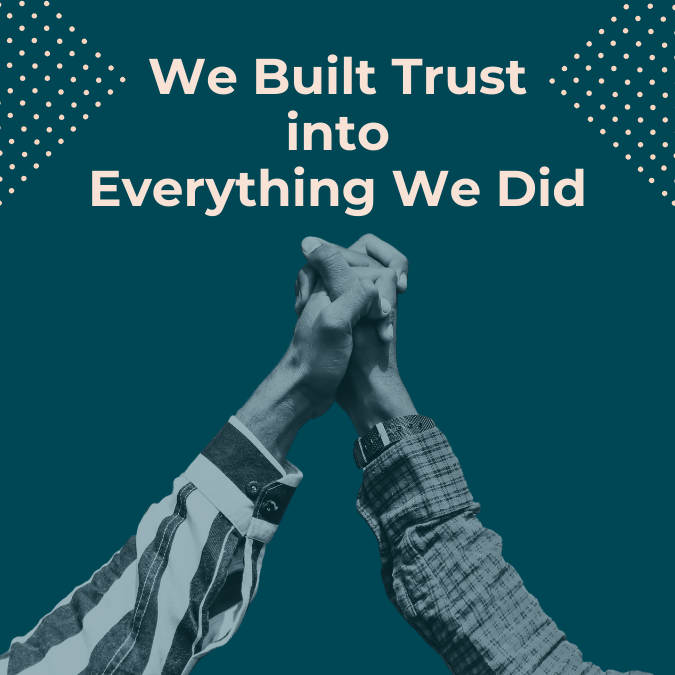In today’s dynamic workplaces, effective team communication is not just a buzzword; it’s the cornerstone of collaboration, innovation, and ultimately, success. However, fostering genuine and productive communication can be a challenge, especially in diverse teams where individuals may have different communication styles, backgrounds, and perspectives.
Enter the concept of Radical Candor by Kim Scott, a framework for giving and receiving feedback that is both caring and direct. When combined with the principles of equitable conversations we have shared in past newsletters, Radical Candor can transform team communication, by creating an environment where everyone feels valued, respected, and empowered to contribute their best.
Trust your resources
Radical Candor is a valuable resource for creating a new workplace culture. Kim Scott doesn’t hold back on feedback for all employees, especially management. Each chapter deconstructs the “traditional,” work culture to create open dialogue opportunities for team members and management. This includes criticism, feedback, and welcoming all personalities. If you haven’t read Radical Candor, I encourage it.
We use Radical Candor with our clients as a foundation for having hard conversations. Statistically women and people of color are far less likely to receive feedback that improves performance and supports promotion. Instead, feedback is often given on personality or demeanor. Providing direction and expectations on how to give and receive feedback within diverse teams ensures retention, creativity, and safety. Here are 5 lessons I took from the book.
5 Lessons from Radical Candor
- Communication is a two-way street.
Scott opens the conversation with communication. Communication is key for any partnership or relationship. As employees, there should be a clear line of communication, and see your team as people, not robots. As someone who loves to talk, I had a hard time in previous roles communicating my needs or giving feedback to peers or even my management. The fear of a title, being a Black woman and asking for space to speak in a place that historically doesn’t listen to voices like mine. It brought my vocal cords to a halt. Scott encourages that no matter the title or how you may identify, there should be an open line of communication. Keeping the line open, removes barriers and creates a space for everyone to share which can result in better results as a team.
Communication is key but more importantly, communication and giving criticism or feedback. Feedback or criticism can be given in a way that makes the employee feel belittled or not valued. After having a long team meeting about revamping our services and stepping up with our service. The team asked and they shall be received. After a few weeks, it was time to check in to see how things were going. During the check-in, I remember being given feedback that I was not too sure how to accept it. I received high praise for how I worked with stakeholders in my community and admired my great service. Even though it was great and I did what was being asked. I was given feedback that they were happy with my work but I did too well. I was given a feedback sandwich that was giving sloppy Joe. Scott shares tips on how to balance the two, praise and correction. Be specific when giving praise but also contextualize to notice achievement. In the book, Scott suggests giving immediate feedback. Giving corrections at the moment is not a bad thing. It helps fix mistakes sooner so everyone can continue on an upward trend.
- Rockstar vs. Superstar Feedback
In chapter three, it gave me a concept of what type of employee I am. Rockstar vs. Superstar. Scott did an amazing explanation of two stars. Superstars are inspired to grow on the path to change and are ambitious. Rockstars have a more gradual growth trajectory. One is not better than the other, they pair very well together to support each other. In a previous role, I would identify as a Superstar but my coworker identifies as a Rockstar. As a team, we learned how to work together and support while encouraging each other in our work. More importantly, we became each other’s number-one fans.
- Setting the tone with Agreements
Scott includes their work experience at Google and a gem that stuck with her. Google’s “7 Elements to Drive Results Collaboratively.” The elements give clear guidelines on how a team can be effective but more importantly, work together in a healthy environment. It reminds me of CTP’s agreements and values. It gives clarity on our mission, keeps a grounded foundation, and keeps our why at the forefront.
- A new to combine work and life.
Another great point that was made is about balance. A commonly used term for balance is “work-life” balance. If anyone asked me how my work-life balance is, I would always answer, “What is that?” Growing up I was shown that work is life so there is nothing to balance. The older I got, I learned having a life while working is important to me. Scott gave a new perspective. Instead of a work-life balance separating work and social life. Why not bring them together and be your whole self at work? Work should also be fun. Bringing in the joy of socializing can create a better environment and balance the worlds, so they can orbit together.
5. Self-care is the best care
In balance, it starts with you. Take care of yourself. It is easier said than done. Trust me, I am speaking from personal experience! This is a nuance for my community. Self-care is a luxury that a Black woman, myself, couldn’t afford to think of. As I continue to work in spaces where self-care has been discussed. I took notice of how my body would shut down because of how much I valued work over myself. I took small steps to implement at least one thing to take care of myself in my work day. Which then expanded from the work week to weekends, and to a daily practice. For historically marginalized communities, self-care may seem like a luxury, but it is a crucial investment in personal well-being. Self-care should be the center of it all. You are human and doing great work. Taking care of oneself becomes paramount for sustained success and fulfillment. The role and work can’t be done if you are not focused on what you need for yourself. Reminding you once again, to take care of yourself.
Radical Candor has many gems. The biggest prize of it all is the four quadrants:
The lines that divide each quadrant are a guideline of how each part can be displayed or addressed. It can be careful, silent, challenged, or a favorite curse word. Inside the lines are:
- Ruinous empathy silences the truth about what the person needs to know. Saving face to save feelings will stunt the growth of a team. If feedback is necessary don’t let fear of feelings hold you back from telling the truth. It may turn out to be better than you think.
- Manipulative insincerity is the opposite of ruinous empathy. It’s when you don’t care enough about the person or situation. Comments or feedback is given in a passive-aggressive tone.
- Obnoxious aggression is intentionally embarrassing someone about how bad they did or even yelling across the room to tell the person their zipper is down. It’s like the class clown but with the personality of Pennywise. Scary approach in any given situation.
- Radical Candor can be a blend of all the above but there is an art of personally caring with a direct approach. Balance of candid feedback.
Racial Candor quadrants have diverse ways of approaching team feedback or communication dynamics. This can help with how to communicate to each team member in a way that each person is heard and seen. For example, there may be someone on the team who is more shy and uses a careful approach with radical candor while being direct. The person being addressed doesn’t feel uncomfortable but opens a window of opportunity for them to open up more and trust you.
Everyone is different but with radical candor and the quadrants it can create an equitable way to communicate with each other.
Incorporating Radical Candor into your team dynamic can pave the way for a workplace revolution. As a facilitator within CTP, embracing these principles can lead to a radical liberation workspace, where every individual feels a true sense of belonging. The art of giving feedback can embark on a journey with Radical Candor, and watch as your workplace transforms into a space where authenticity and belonging thrive.




0 Comments